Which file system should be used for removable storage devices
TipsMake.com - In the tutorial article below, we will learn about some concepts related to file system - file system for use with portable storage devices. In essence, file systems are extremely important components in an operating system, which are assigned by user accounts. However, if there is only that, there will be many misunderstandings, so please read and pay close attention to the information presented below.

For simplicity, we can understand that file system is the way to classify and sort data, and each type of file system is attached to a certain operating system. Since binary files can be written to the hard drive, the file system has become an important link in reading data from that storage device by the operating system.

This day, due to the demand for personal interests as well as work, many people have installed two or more operating systems on the computer, followed by the data storage process has also become a lot different. And the simplest way is to use an external removable storage device, such as a USB Flash drive, a removable hard drive . but this approach also faces many difficulties when transferring data between systems. operating, most of which are related to flexibility and limited capacity support.
Flexibility:

Currently, we all know about some of the most popular file system standards today: NTFS (Windows Standard), HFS + (OS X Standard) and FAT32 (old Windows Standard). Most users think that modern operating systems today will be compatible and support each other file system formats, but in reality they are not. Mac OS (even the latest version is now Lion ) cannot record files to the partition after being formatted with NTFS , and Windows 7 cannot recognize the HFS + hard drive, and will display marketed Unformatted partitions.
Besides, many popular Linux distros (mostly Ubuntu ) are well prepared to solve this problem, users just need to download and install some supporting software that can be accessed. Access and use archives on other formatted partitions.
On the other hand, some other devices such as Xbox 360 and Playstation 3 are still quite limited in this regard, and support USB standard. To better understand the above information, please refer to the chart below:
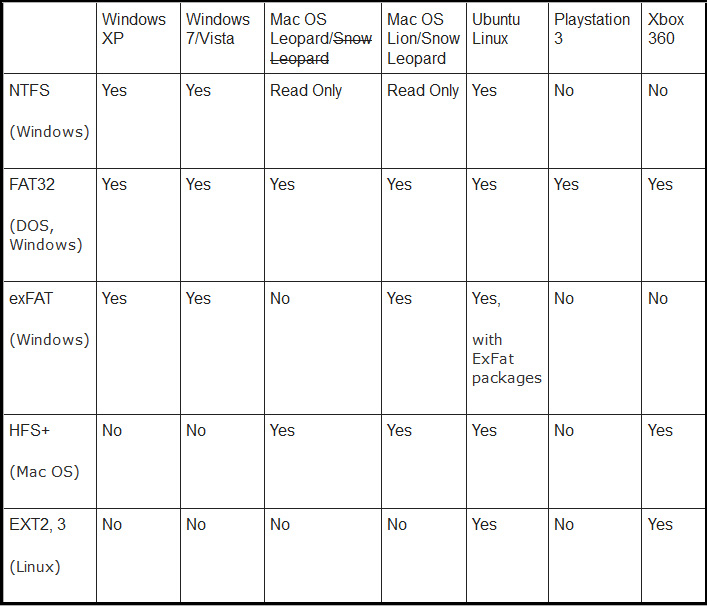
Limitations on maximum support capacity:
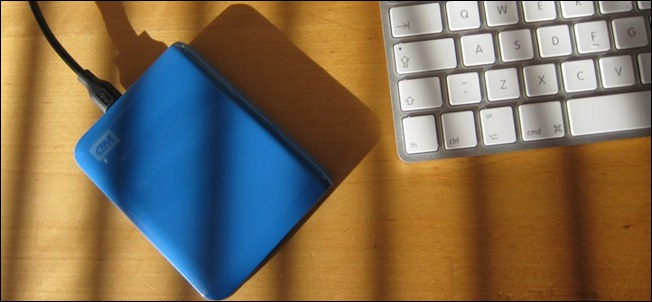
FAT32 was redeveloped many years ago, based on the old file system FAT , meaning for DOS-based computers. Therefore, storage devices with 'terrible' capacity as today are only theoretical in previous times, and this is understandable when FAT32 format only supports files with dark capacity. Multi is 4GB.
Please refer to the chart below to learn more about the general development process of FAT32 format:
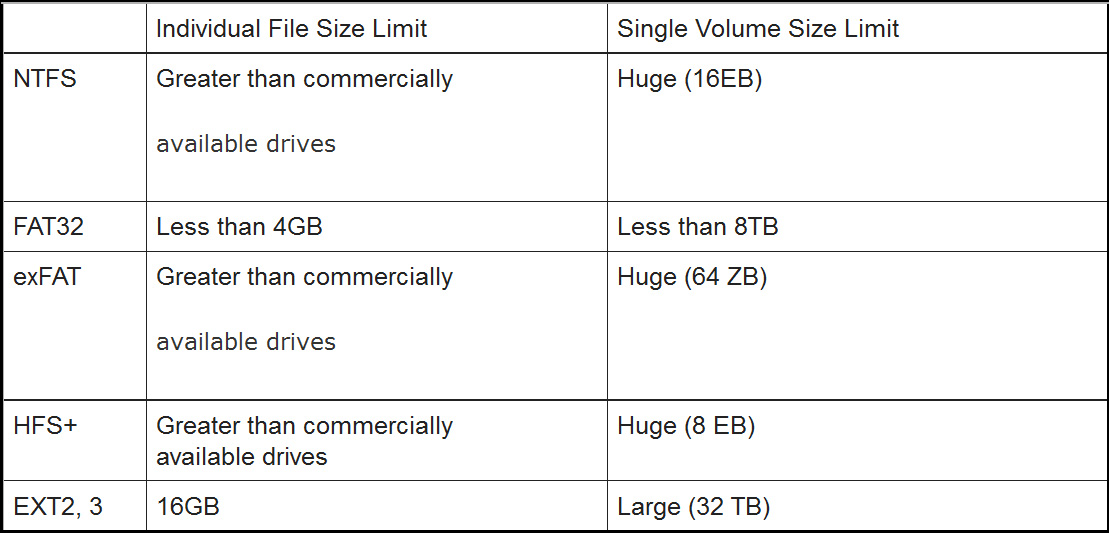
Up to now, most of the new generation 'file systems' have proved to be far superior to FAT32 , for example EXT has supported up to 16GB of maximum file size (up to 2TB in size). on some systems). Besides, there are some other formats, and the support capacity is no longer calculated according to Gigabyte units, but Petabytes .
Through some basic points as above, we have partly seen the basic limitations of FAT32 - the "successor" of FAT, but this can still be considered a success of Microsoft in the long run. that time. The basic rules of FAT32, if properly applied, still maximize the efficiency of many normal systems and users.
Format storage devices:
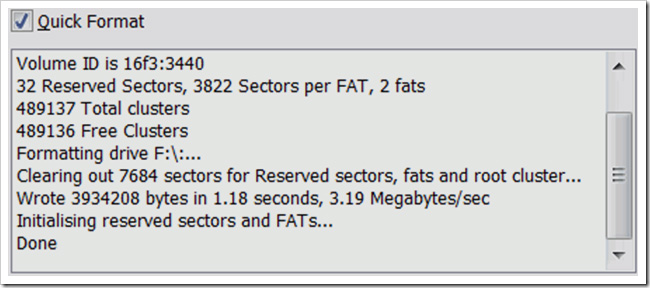
FAT32 : Depending on the file system and the software used for formatting, we can create FAT32 partitions with very large capacities, up to several TB:
- Fat32 Format for Windows: tool to assist in formatting the hard drive, FAT32 partition with a simple and easy-to-use graphical interface
- Disk Utility for Mac: one of the simplest tools for Mac users
- GParted for Linux is a free and open source application for partition editing, besides it supports FAT32.
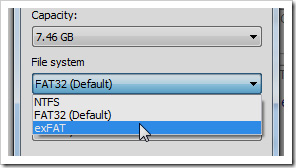
NTFS or exFAT: in fact, exFAT does not really support the system as well as we know it, but NTFS is the exact opposite, very suitable for Windows and Linux users, even some sessions. The latest version of Mac OS X. Here are some simple steps to format partitions with NTFS or exFAT:
- Computer Management (Windows 7): Open Start Menu and type Computer Management, the system will display the corresponding tool. Here, you just need to use Disk Management to manipulate the partition on the system by right-clicking.
- Quick Format (Windows 7) : look at the listed and sorted partitions in the My Computer section, right-click and choose Format, then NTFS or exFAT, depending on your needs.
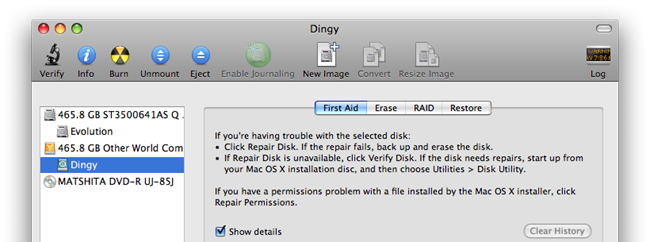
HFS +: In essence, we don't need to use it without more manipulation on the Mac operating system. In this case, Disk Utility for Mac OS is the better choice:
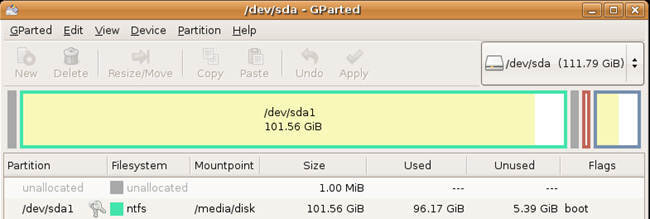
EXT 2 or EXT 3: In addition to the quite good support for FAT32, GParted will help us easily create and manage better partitions, thereby improving the performance of the Linux system.
Good luck!
You should read it
- Basic file system in Unix / Linux
- Tips for reformatting USB to run on Windows, Linux, Mac and many other operating systems
- Learn the file system and folders on Linux operating systems
- How to mount a Linux file system using WSL2 on Windows 10
- Use Journalctl to read the system log on Linux
- Compare 4 current TV operating systems
- Learn about computer file management systems
- 3 simple ways to enable / disable the Encrypting File System
May be interested
- Ways to set USB passwords for data protection
 usb is small, compact, portable storage devices and users can read on any device that supports usb port. because of these features, usb becomes one of the perfect data transfer and storage devices among computers.
usb is small, compact, portable storage devices and users can read on any device that supports usb port. because of these features, usb becomes one of the perfect data transfer and storage devices among computers. - Data storage: That day and now
 the smaller the storage drive size, the more storage capacity ... that is the biggest change in the last 6 decades.
the smaller the storage drive size, the more storage capacity ... that is the biggest change in the last 6 decades. - Easily solve 3 common system errors
 the file system is corrupted, the account is blocked, and the data being mistakenly deleted are the three most worrisome issues when using the computer that people often have to back up the hard drive.
the file system is corrupted, the account is blocked, and the data being mistakenly deleted are the three most worrisome issues when using the computer that people often have to back up the hard drive. - Enable / disable ReFS (Resilient File System) on Windows 10
 refs was first introduced on windows 8.1 and windows server 2012, and was designed to maximize available data and reliability even if the related storage device had a hardware failure.
refs was first introduced on windows 8.1 and windows server 2012, and was designed to maximize available data and reliability even if the related storage device had a hardware failure. - How to view all connected storage devices on Windows 10
 if you search for drives connected on windows 10 version 1903, you will see some devices are missing. in fact, they are not there and this is how to find them through the settings application.
if you search for drives connected on windows 10 version 1903, you will see some devices are missing. in fact, they are not there and this is how to find them through the settings application. - How to use Cozy Drive multi-platform data storage
 cozy drive is a cross-platform cloud storage service with 5gb of free storage. we can access and use offline, synchronize data on different devices.
cozy drive is a cross-platform cloud storage service with 5gb of free storage. we can access and use offline, synchronize data on different devices. - How to share your self-destruct file with Degoo
 degoo is a self-destruct file storage and sharing service with large files. the file will automatically cancel after 7 days when the user uploads.
degoo is a self-destruct file storage and sharing service with large files. the file will automatically cancel after 7 days when the user uploads. - How to use Terabox storage with 1TB for free
 terabox service stores data with a free capacity of up to 1024gb so you can comfortably save data cross-platform on your phone and computer. with terabox, all data stored in the account is kept safe and secure, preventing theft.
terabox service stores data with a free capacity of up to 1024gb so you can comfortably save data cross-platform on your phone and computer. with terabox, all data stored in the account is kept safe and secure, preventing theft. - How to Format USB on a computer
 how to format usb on a computer. usb is a removable storage device that has been present for a long time and is still used by many people because of its utility to store data. with old-fashioned usbs that were both large in size and had small storage capacity, now u
how to format usb on a computer. usb is a removable storage device that has been present for a long time and is still used by many people because of its utility to store data. with old-fashioned usbs that were both large in size and had small storage capacity, now u - 10 tips to keep cloud storage safe and secure
 cloud storage has made it easy to sync files, share them, keep multiple versions of a file, etc. not only limited to backups, cloud storage has also completely replaced disk storage. physical storage for some users.
cloud storage has made it easy to sync files, share them, keep multiple versions of a file, etc. not only limited to backups, cloud storage has also completely replaced disk storage. physical storage for some users.










 7 reasons to upgrade to Firefox 7
7 reasons to upgrade to Firefox 7 Find IP address and MAC address
Find IP address and MAC address 4 ways to 'run away' harassers on Facebook Chat
4 ways to 'run away' harassers on Facebook Chat 10 common errors in virtualization
10 common errors in virtualization Backup from this computer to another computer
Backup from this computer to another computer Learn about the conhost.exe process in Windows
Learn about the conhost.exe process in Windows